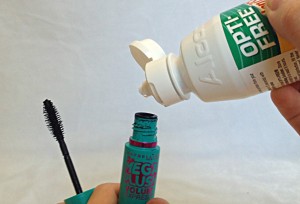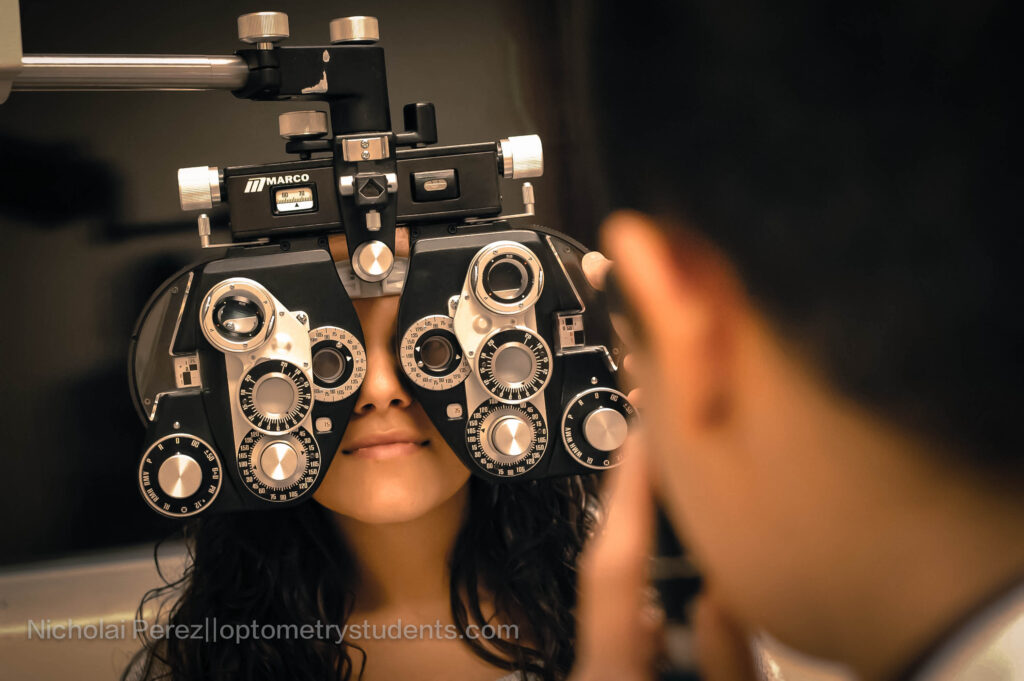Whether you’re a veteran in clinic or fresh out of the box, at some point or another we will all encounter a heavy eye makeup-wearing patient. As a makeup enthusiast myself and freelance artist, I see that there are many misconceptions among the general public regarding their eye health. Many people aren’t aware of the potential risks that this garden variety item they pick up at the department or drugstore can have on their vision and their health.
Throw mascara away every three months.
This is one area where there should be no misconception. This is the one beauty product which should be replaced the most frequently. It’s placed on and around the lashes and lash base. Bacteria and skin cells from the lashes are placed back into the tube once the wand is replaced, and grow inside the tube. Once the mascara “dries out”, it’s time to throw it  out – around every 90 days. There should be no “reviving it” with contact lens solution like some websites advocate. These practices can lead to bacterial and viral conjunctivitis, blepharitis, and MGD.
out – around every 90 days. There should be no “reviving it” with contact lens solution like some websites advocate. These practices can lead to bacterial and viral conjunctivitis, blepharitis, and MGD.
This practice of adding contact lens solution to mascaras to lengthen the shelf life, popular now due to sites like Pinterest, is potentially harmful to your patients and increases their risk of conjunctivitis and other anterior segment infections/inflammations.
Put contacts in before putting makeup on.
Putting any contact lens in (soft or RGP) prior to makeup application is vital to decreasing debris that can get trapped behind the lens and irritate the eye. If makeup is applied prior to lens insertion, microscopic powder can float in the tear film and get trapped behind the lens. After lens is inserted, particles can touch the sensitive corneal nerves and cause reflex tearing. This can cause smearing of more of the makeup previously applied, causing more of a vicious cycle and potentially causing a corneal or conjunctival microabrasion. If the lens is rubbed with debris underneath, the problem can worsen and cause more potential problems for the cornea.
Never sleep with makeup on.
One of the most crucial elements to eye health is not sleeping in makeup (or contact lenses). The eyes and skin need to breathe – they regenerate overnight. Removing eye makeup with either an oil based remover or either a facial cleansing wipe before bed greatly decreases the risk of blepharitis, conjunctivitis, and inflammatory diseases. In the same vein, make sure your patients are taking their contacts out if they are CL patients (unless they are in an overnight approved lens) to decrease the risk of keratitis and corneal ulceration.
“Waterlining” can cause multiple problems.
This common practice among women involves putting eyeliner on the inside inner rims of the eye. Often black pencil, it can flake off into the eye, causing irritation, debris in the tear film, and decreased inferior tear lake. Debris may be more likely to stick to soft contact lenses if the patient wears contacts as well. Pigment may also block the inferior punctum and cause a blockage, leading to epiphora and potential infection. While many women (and some men) will continue to do this, talk to your patient and encourage them to stop by explaining the problems involved. If the patient is complaining of dry eyes and/or irritation, it may be more problematic.
Don’t share eye makeup.
It’s nice to want to try out a brand new color of liner or try a mascara because it’s awesome. But this is one area where it’s not a great idea to try before you buy. This also applies to department store counters. Unless they use disposable wands for each client, don’t let them sample from the bottle. If one person who tried that tube had staph bleph or EKC, now the entire clientele (or group of friends) does.
False/added products can induce or worsen dry eyes.
False eyelashes, glitter, etc. all add weight to the upper eyelid. This in turn decreases the blink rate since the upper lid is heavier. Decreasing the blink rate in turn causes the eyes to dry out faster even if the patient doesn’t have dry eyes to begin with. If your patient is a fan of these, encourage them to keep re-wetting drops with them to keep their eyes lubricated and to increase patient comfort.
Make sure your cosmetic contact lens patients are coming to you.
Many patients do not understand what goes into a contact lens fitting and the importance of doing so. Some people will buy colored or “circle” (larger scleral colored lenses) contact lenses at the beauty salon, on the internet, etc. If you see a patient wearing a colored lens that you didn’t prescribe, gently figure out to where they got them, and educate on proper lens fitting, CL hygiene, etc. (especially if they came from an illegitimate retailer and not a licensed doctor!).
Skip all eye makeup with an inflamed or infected eye.
Some patients don’t seem to understand that their eye makeup may be exacerbating (and often causing!) their red eye. It can be a real challenge to explain to them that they should have a naked eye, including no contact lenses, to heal and get rid of the problem. Putting any foreign object in the eyes with an infection or inflammation is only going to lengthen the healing process. Any time you’re introducing a therapeutic drop (i.e. an antibiotic), you want to make sure it’s getting to the affected area, and making sure that makeup isn’t blocking absorption of the drug and/or acting antigenic (thus slowing healing).
The eyes are the windows to the soul, and many people like to enhance theirs a bit. Make sure your patients are well informed that a normal everyday item to them is seen as a foreign object to their eye, and can inflict a great deal of damage when abused. Lastly, make sure to have a good rapport with your patients so they trust your advice, and if they do run into problems, they will come to you.


